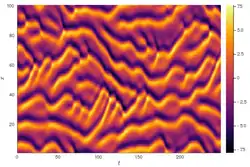Kuramoto–Sivashinsky equation
In mathematics, the Kuramoto–Sivashinsky equation (also called the KS equation or flame equation) is a fourth-order nonlinear partial differential equation,[1] named after Yoshiki Kuramoto[2] and Gregory Sivashinsky, who derived the equation to model the diffusive instabilities in a laminar flame front in the late 1970s.[3][4] The equation reads as

A spatiotemporal plot of a simulation of the Kuramoto–Sivashinsky equation
where is the Laplace operator and its square, is the biharmonic operator. The Kuramoto–Sivashinsky equation is known for its chaotic behavior.[5]
See also
References
- Weisstein, Eric W. "Kuramoto-Sivashinsky Equation". MathWorld. Wolfram Research.
- Kuramoto, Y. (1978). Diffusion-induced chaos in reaction systems. Progress of Theoretical Physics Supplement, 64, 346-367.
- Sivashinsky, G. S. (1977). Nonlinear analysis of hydrodynamic instability in laminar flames—I. Derivation of basic equations. In Dynamics of Curved Fronts (pp. 459-488).
- Sivashinsky, G. I. (1980). "On flame propagation under conditions of stoichiometry". SIAM Journal on Applied Mathematics. 39 (1): 67–82. doi:10.1137/0139007.
- Pathak, Jaideep; Hunt, Brian; Girvan, Michelle; Lu, Zhixin; Ott, Edward (2018). "Model-Free Prediction of Large Spatiotemporally Chaotic Systems from Data: A Reservoir Computing Approach". Physical Review Letters. 120 (2): 024102. doi:10.1103/PhysRevLett.120.024102. ISSN 0031-9007.
This article is issued from Wikipedia. The text is licensed under Creative Commons - Attribution - Sharealike. Additional terms may apply for the media files.